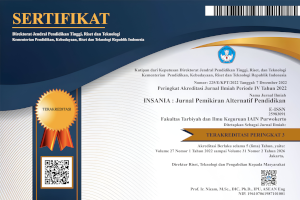Analisis Hasil Pembelajaran Matematika pada Ranah Afektif Mahasiswa Calon Guru di IAIN Purwokerto
Analisis Hasil Pembelajaran Matematika pada Ranah Afektif Mahasiswa Calon Guru di IAIN Purwokerto
DOI:
https://doi.org/10.24090/insania.v22i2.1224Kata Kunci:
affective, student, mathematics, teacherAbstrak
Seperti pelajaran lainnya, matematika memiliki tujuan belajar di ranah afektif selain pada ranah kognitif dan psikomotor. Secara umum, hal ini dapat dilihat pada perumusan tujuan pembelajaran matematika, seperti yang dinyatakan dalam kurikulum. Keberhasilan belajar dalam kognitif dan psikomotor sangat dipengaruhi oleh kondisi afektif siswa. Siswa yang memiliki minat belajar dan sikap positif terhadap matematika akan senang belajar matematika sehingga hasil belajar yang optimal dapat tercapai. Mahasiswa Fakultas Tarbiyah sebagai calon guru harus memiliki afektif yang baik agar tidak mempersulit siswa di masa depan. Artikel ini menjelaskan tentang afektif siswa dalam matematika. Menurut data, dapat disimpulkan bahwa afektif siswa itu baik. Kondisi ini harus dipelihara dan ditingkatkan.Unduhan
Referensi
Arifin. 2009. Evaluasi Pembelajaran Prinsip Teknik. Prosedur. Bandung: Remaja Rosdakarya.
Bandura, A. 1997. Self-Efficacy: The Exercise of Control. New York: W. H. Freeman & Company
Depdiknas. 2006. Permendiknas Nomor 22 Tahun 2006 Tentang Standar Isi Sekolah
Menengah Atas. Jakarta: Depdiknas.
Guardian. 2013. PISA 2012 Results: Which Country Does Best at Reading, Maths and Science?, Tersedia: http://www.theguardian.com/news/datablog/2013/dec/03/pisa-results-country-best-reading-maths-science. [6 Februari 2014]
Hardianto, D. 2011. Studi tentang Minat Baca Mahasiswa Fakultas Ilmu Pendidikan UNY. Tersedia:http://staff.uny.ac.id/sites/default/files/Studi%20Tentang%20 Minat%20Baca%20Mahasiswa%20FIP%20UNY_0.pdf (Diakses 10 Februari 2015)
Hasanah, D. F. 2013. Faktor-faktor yang Mempengaruhi Minat Kunjung Pemustaka di Perpustakaan Fakultas Kedokteran Universitas Gadjah Mada. Skripsi UIN Sunan Kalijaga Yogyakarta: Tidak Dipublikasikan.
Hisyam, Z. 2008. Strategi Pembelajaran Aktif. Yogyakarta: Insan Mandiri.
Hudojo, H. 2005. Pengembangan Kurikulum dan Pembelajaran Matematika. Malang: UM Press.
Kompas. Minat Baca Indonesia Ada di Urutan ke-60 Dunia. 29 Agustus 2016. Tersedia: http://edukasi.kompas.com/read/2016/08/29/07175131/minat.baca.indonesia.ada.di.urutan.ke-60.dunia [2 November 2017]
Mardapi, D. 2004. Penyusunan Tes Hasil Belajar. Yogyakarta: Program Pascasarjana Universitas Negeri Yogyakarta.
Pamuji, T., Budiyono, dan Yuzianah, D. 2014. Persepsi terhadap Mata Pelajaran Matematika Siswa SMP kelas VIII. Jurnal Ekuivalen. Tersedia: http://ejournal.umpwr.ac.id/index.php/ekuivalen/article/viewFile/1788/1691. [28 Mei 2015]
Salafudin. 2013. Pendidikan Karakter melalui Pembelajaran Matematika. Jurnal Penelitian, Vol. 10, No. 1, Mei 2013 hal 63-76.
Sumarmo, U. 1987. Kemampuan Pemahaman dan Penalaran Matematika Siswa SMA dikaitkan dengan Kemampuan Penalaran Logik Siswa dan Beberapa Unsur Proses Belajar Mengajar. Disertasi UPI Bandung: Tidak Diterbitkan.
Unduhan
Diterbitkan
Cara Mengutip
Terbitan
Bagian
Lisensi
Authors who publish with this journal agree to the following terms:
Authors retain copyright and grant the journal right of first publication with the work simultaneously licensed under a Creative CommonsAttribution-ShareAlike License that allows others to share the work with an acknowledgment of the work's authorship and initial publication in this journal.
Authors are able to enter into separate, additional contractual arrangements for the non-exclusive distribution of the journal's published version of the work (e.g., post it to an institutional repository or publish it in a book), with an acknowledgment of its initial publication in this journal.
Authors are permitted and encouraged to post their work online (e.g., in institutional repositories or on their website) prior to and during the submission process, as it can lead to productive exchanges, as well as earlier and greater citation of published work (See The Effect of Open Access).








